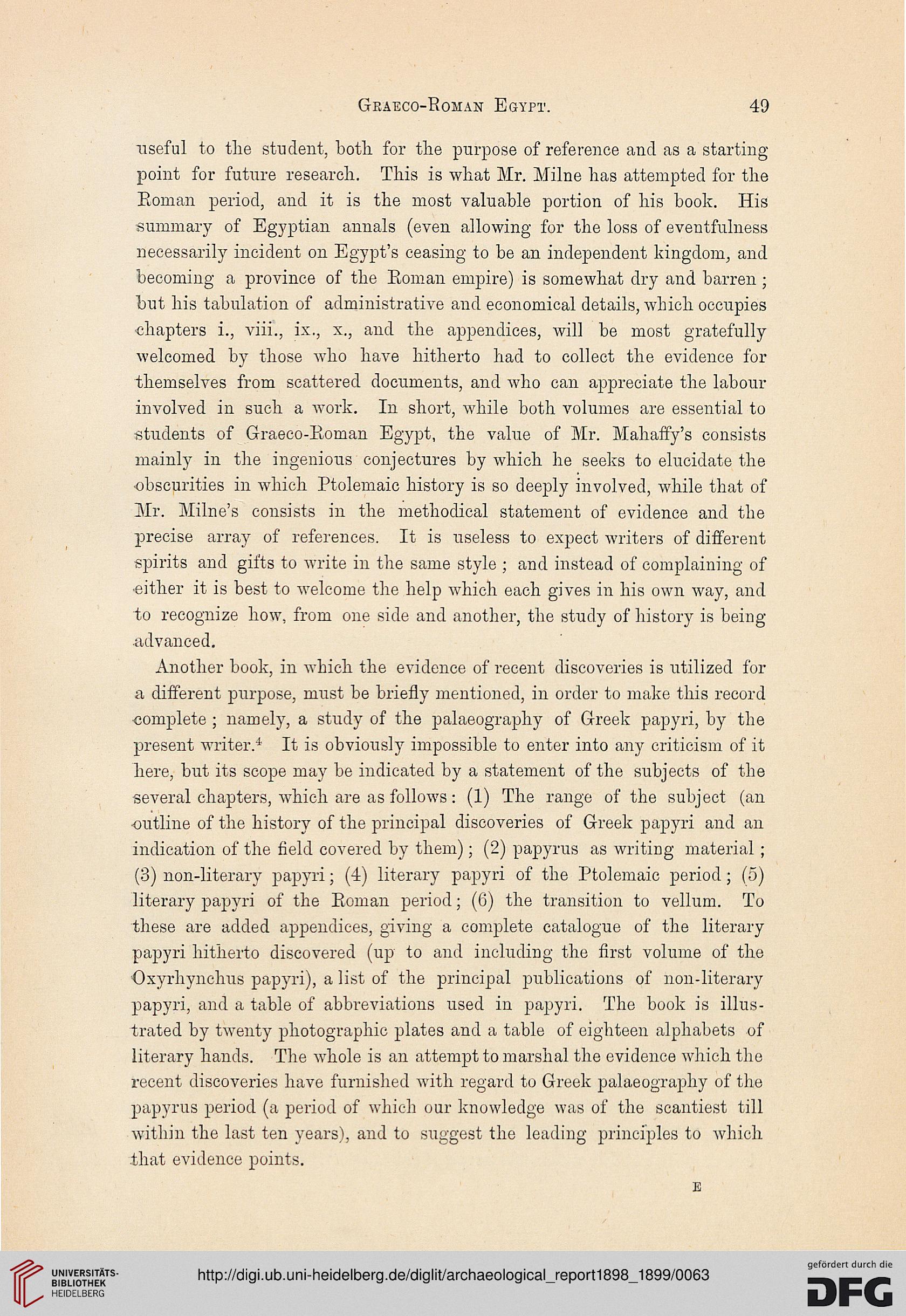Geaeco-Roman Egypt.
49
useful to the student, both for the purpose of reference and as a starting-
point for future research. This is what Mr. Milne has attempted for the
Roman period, and it is the most valuable portion of his book. His
summary of Egyptian annals (even allowing for the loss of eventfulness
necessarily incident on Egypt's ceasing to be an independent kingdom, and
becoming a province of the Roman empire) is somewhat dry and barren ;
but his tabulation of administrative and economical details, which occupies
chapters i., viii., ix., x., and the appendices, will be most gratefully
welcomed by those who have hitherto had to collect the evidence for
themselves from scattered documents, and who can appreciate the labour
involved in such a work. In short, while both volumes are essential to
students of Graeeo-Roman Egypt, the value of Mr. Mahaffy's consists
mainly in the ingenious conjectures by which he seeks to elucidate the
obscurities in which Ptolemaic history is so deeply involved, while that of
Mr. Milne's consists in the methodical statement of evidence and the
precise array of references. It is useless to expect writers of different
spirits and gifts to write in the same style ; and instead of complaining of
either it is best to welcome the help which each gives in his own way, and
to recognize how, from one side and another, the study of history is being-
advanced.
Another book, in which the evidence of recent discoveries is utilized for
a different purpose, must be briefly mentioned, in order to make this record
complete ; namely, a study of the palaeography of Greek papyri, by the
present writer.4 It is obviously impossible to enter into any criticism of it
here, but its scope may be indicated by a statement of the subjects of the
several chapters, Avhich are as follows: (1) The range of the subject (an
outline of the history of the principal discoveries of Greek papyri and an
indication of the field covered by them); (2) papyrus as writing material ;
(3) non-literary papyri; (4) literary papyri of the Ptolemaic period; (5)
literary papyri of the Roman period; (6) the transition to vellum. To
these are added appendices, giving a complete catalogue of the literary
papyri hitherto discovered (up to and including the first volume of the
Oxyrhynchus papyri), a list of the principal publications of non-literary
papyri, and a table of abbreviations used in papyri. The book is illus-
trated by twenty photographic plates and a table of eighteen alphabets of
literary hands. The whole is an attempt to marshal the evidence which the
recent discoveries have furnished with regard to Greek palaeography of the
papyrus period (a period of which our knowledge was of the scantiest till
within the last ten years), and to suggest the leading principles to which
that evidence points.
£
49
useful to the student, both for the purpose of reference and as a starting-
point for future research. This is what Mr. Milne has attempted for the
Roman period, and it is the most valuable portion of his book. His
summary of Egyptian annals (even allowing for the loss of eventfulness
necessarily incident on Egypt's ceasing to be an independent kingdom, and
becoming a province of the Roman empire) is somewhat dry and barren ;
but his tabulation of administrative and economical details, which occupies
chapters i., viii., ix., x., and the appendices, will be most gratefully
welcomed by those who have hitherto had to collect the evidence for
themselves from scattered documents, and who can appreciate the labour
involved in such a work. In short, while both volumes are essential to
students of Graeeo-Roman Egypt, the value of Mr. Mahaffy's consists
mainly in the ingenious conjectures by which he seeks to elucidate the
obscurities in which Ptolemaic history is so deeply involved, while that of
Mr. Milne's consists in the methodical statement of evidence and the
precise array of references. It is useless to expect writers of different
spirits and gifts to write in the same style ; and instead of complaining of
either it is best to welcome the help which each gives in his own way, and
to recognize how, from one side and another, the study of history is being-
advanced.
Another book, in which the evidence of recent discoveries is utilized for
a different purpose, must be briefly mentioned, in order to make this record
complete ; namely, a study of the palaeography of Greek papyri, by the
present writer.4 It is obviously impossible to enter into any criticism of it
here, but its scope may be indicated by a statement of the subjects of the
several chapters, Avhich are as follows: (1) The range of the subject (an
outline of the history of the principal discoveries of Greek papyri and an
indication of the field covered by them); (2) papyrus as writing material ;
(3) non-literary papyri; (4) literary papyri of the Ptolemaic period; (5)
literary papyri of the Roman period; (6) the transition to vellum. To
these are added appendices, giving a complete catalogue of the literary
papyri hitherto discovered (up to and including the first volume of the
Oxyrhynchus papyri), a list of the principal publications of non-literary
papyri, and a table of abbreviations used in papyri. The book is illus-
trated by twenty photographic plates and a table of eighteen alphabets of
literary hands. The whole is an attempt to marshal the evidence which the
recent discoveries have furnished with regard to Greek palaeography of the
papyrus period (a period of which our knowledge was of the scantiest till
within the last ten years), and to suggest the leading principles to which
that evidence points.
£




